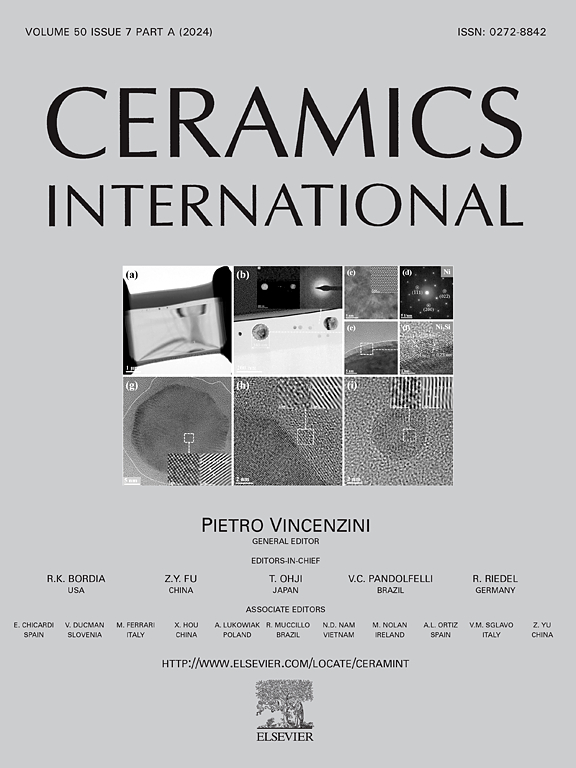前驱体溶液搅拌时间对溶胶-凝胶法制备Pb(Zr,Ti)O3薄膜结构和电性能的影响
IF 5.6
2区 材料科学
Q1 MATERIALS SCIENCE, CERAMICS
引用次数: 0
摘要
采用溶胶-凝胶法制备了Pb0.40(Zr0.65Ti0.35)O3 (PZT)薄膜。结果表明,增加搅拌时间可以改变PZT薄膜的取向,使其表面更加均匀,粗糙度降低。与搅拌5 h的前驱体制备的PZT膜相比,搅拌13.5 h的前驱体制备的PZT膜具有增强的铁电极化,更高的介电常数和更明显的电畴响应。利用标度定律和瑞利模型分别分析了PZT薄膜的畴切换和畴壁运动。研究表明,通过调整前驱体溶液的搅拌时间,可以有效地控制铁电薄膜的结晶取向,优化铁电性能和介电性能。本文章由计算机程序翻译,如有差异,请以英文原文为准。
Effects of precursor solution stirring time on structural and electrical properties of Pb(Zr,Ti)O3 films fabricated by sol-gel method
Pb0.40(Zr0.65Ti0.35)O3 (PZT) films were prepared by the sol-gel method using precursor solutions with different stirring time. It was found that the orientation of the PZT films can be altered by increasing the stirring time, as well as producing more uniform surfaces and reduced roughness. Compared to the film prepared from the precursor stirred for 5 h, the PZT film prepared from the precursor stirred for 13.5 h exhibited enhanced ferroelectric polarization, higher permittivity and more pronounced electrical domain responses. The domain switching and domain wall motion in the PZT films were analyzed by scaling laws and the Rayleigh model, respectively. This study demonstrates that by adjusting the stirring time of the precursor solution, the crystalline orientation of the ferroelectric films can be effectively controlled and the ferroelectric and dielectric properties can be optimized.
求助全文
通过发布文献求助,成功后即可免费获取论文全文。
去求助
来源期刊

Ceramics International
工程技术-材料科学:硅酸盐
CiteScore
9.40
自引率
15.40%
发文量
4558
审稿时长
25 days
期刊介绍:
Ceramics International covers the science of advanced ceramic materials. The journal encourages contributions that demonstrate how an understanding of the basic chemical and physical phenomena may direct materials design and stimulate ideas for new or improved processing techniques, in order to obtain materials with desired structural features and properties.
Ceramics International covers oxide and non-oxide ceramics, functional glasses, glass ceramics, amorphous inorganic non-metallic materials (and their combinations with metal and organic materials), in the form of particulates, dense or porous bodies, thin/thick films and laminated, graded and composite structures. Process related topics such as ceramic-ceramic joints or joining ceramics with dissimilar materials, as well as surface finishing and conditioning are also covered. Besides traditional processing techniques, manufacturing routes of interest include innovative procedures benefiting from externally applied stresses, electromagnetic fields and energetic beams, as well as top-down and self-assembly nanotechnology approaches. In addition, the journal welcomes submissions on bio-inspired and bio-enabled materials designs, experimentally validated multi scale modelling and simulation for materials design, and the use of the most advanced chemical and physical characterization techniques of structure, properties and behaviour.
Technologically relevant low-dimensional systems are a particular focus of Ceramics International. These include 0, 1 and 2-D nanomaterials (also covering CNTs, graphene and related materials, and diamond-like carbons), their nanocomposites, as well as nano-hybrids and hierarchical multifunctional nanostructures that might integrate molecular, biological and electronic components.
 求助内容:
求助内容: 应助结果提醒方式:
应助结果提醒方式:


